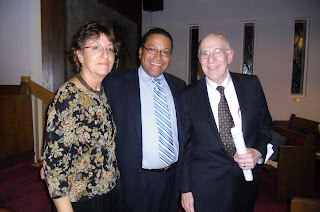National and Local Leaders Speak on Health Disparities and Diversity
September 25, 2011
By Cora Lee Picone
PULSE of NY

(September 30, 2011) This past Sunday members of the community gathered for an informal discussion about Patient Centered Care at the South Nassau Unitarian Universalist Congregation in Freeport, NY. PULSE of NY welcomed Amy Wilson-Stronks and Dr. Terri Ann Parnell to lead the discussion. Amy formerly worked for the Joint Commission and is now an independent advocate and consultant. Dr. Parnell has a background in nursing and is now the Associate Chief Diversity and Inclusion Officer for the North Shore-LIJ Health System in the Office of Diversity, Inclusion & Health Literacy.
The first topic of discussion was the existence of multiple factions of health advocacy. Amy explained that there are three main focus points: language access and culture centered care, health literacy, and physical communication barriers. Language access advocates focus on deaf patients and English language learners. Health literacy, which is defined as an individual’s ability to understand and use health information, is an issue has been embraced by healthcare providers and policy makers. Unfortunately, language access has not received the same support. Physical communication barriers, which often require the assistance of speech-pathologists, receive the least amount of attention.
The main topic of the session was how to achieve patient centered care. Dr. Parnell reminded us that the goal is partnership which cannot be attained without effective communication. We need to encourage patients to speak up and train service providers to feel comfortable asking questions. The most significant impediment is shame or embarrassment which keeps patients from asking questions and prevents doctors from admitting that they are uninformed about a specific topic for fear of losing the respect of the patient.
Amy asked the audience if anyone had made complaints to a health care provider in the past. Many audience members brought up problems they had encountered while trying to do so: medical professionals’ refusal to engage in dialogue, not knowing how to confront the issue, and the lack of access to professionals.
Amy asked the audience “Does everyone know how to engage a provider with a question? Do you know who to call?” Many participants were unsure. One person shared a past experience that involved significant communication roadblock. She tried to contact a healthcare provider in order to obtain an answer to a question. She could not reach an actual human being and was forced to navigate the elaborate answering machine system. Even emailing was unhelpful because it took a week to receive a response. This story demonstrates why it can be so difficult to make a complaint: even communication about non-contentious issues is arduous.
Amy informed the audience that any institution that is accredited by the Joint Commission has a complaint hotline and Dr. Parnell reminded everyone that they can always take a hospital complaint to the administration department. Both Dr. Parnell and Amy encouraged the audience to be persistent about complaints. Many people believe that the problem is indifference on the provider’s part. In most cases, providers are simply overwhelmed and short on time. Dr. Parnell mentioned opposite side of the issue which is that many members of medical staff do not speak up when they believe something was done incorrectly or mishandled because they fear retribution.
Following a comment made by an audience member, the conversation turned to the issue of language access. A woman shared an experience she had when she realized that a fellow patient needed a translator but did not ask for one and instead pretended that she understood a doctor’s explanation. Many patients who require translators are too intimidated to ask for one or simply don’t know that they have the right to request one. An interpreter in the audience confirmed this and added that even though the Joint Commission requires providers to make use of interpreter’s services, they frequently don’t. There is no way for the Joint Commission to enforce this regulation.
Amy responded that the Joint Commission is aware of this because they completed a national study on hospital compliance with translation services and the results were “abysmal”. She pointed out that the greatest barrier is often prejudice; reminding the group that discrimination exists in healthcare. Amy said that it will be a long time before language access is truly accepted due to the common attitude that patients “should just learn English.” Healthcare providers need to be educated on cultural competency and taught how to ask the appropriate questions. An audience member who works in healthcare mentioned that many providers are unaware of their own privilege which protects them from experiencing discrimination and prejudice thus leading them to believe that discrimination does not occur in their facility. He shared that he benefitted tremendously from a workshop given by the local org, Erase Racism and encouraged others to take advantage of that resource.
Amy then shared a personal story to demonstrate that everyone can face communication barriers in healthcare regardless of social class, education level, and language abilities. Her father, even as a practicing physician, faced communication barriers and difficulties while hospitalized. She reminded us that hospitals are required to allow patients to have a supporter with them, someone who can speak up for them when they are unable to do so themselves. She clarified that a supporter is not the same as an interpreter and that patients in need of language services are allowed to have both.
Another topic that was addressed was role of the interpreter. Interpreters try to be neutral but when they get to know patients, they often overstep and take on the role of advocacy. Both Dr. Parnell and Amy agreed that this is inappropriate. Dr. Parnell stated that interpreters should be unbiased. Their role is not to infer. Amy said that while combing advocacy and interpretation is not a good idea, it is always appropriate to mention concerns or complaints to an interpreter because as an employee they are likely to know who is capable of addressing the issue. Amy and Dr. Parnell also mentioned that interpreters can report violations or problems anonymously to the Joint Commission via letter. Ilene volunteered to deliver such letters to the Commission personally if the interpreters were concerned about doing so.
Amy stated that it is important to repeat personal accounts of communication mishaps or barriers as well as complaints. Health care providers are frequently moved by stories but often believe that it doesn’t happen in the facility that employs them. Ilene Corina, President of PULSE of NY, brought up an important method of avoiding miscommunication called the Teach Back Method. Doctors are encouraged to ask a patient to repeat back instructions of explanations allowing them to determine whether or not the patient actually understood what was said. Dr. Parnell agreed that this method is useful and important because many patients feel overwhelmed by the amount of information received before they are discharged. In her view, a pressing issue with the Teach Back Method is training doctors and staff to present the questions a relaxed manner so that the patient doesn’t feel like they are being quizzed.
A member of the Nassau County legislature also attended the event. As a PULSE supporter, David Denenberg urged the audience to get involved with the local government by contacting representatives and the county Board of Health. The changes we want to see have a greater chance of being achieved if our local government aware of our wishes and joins forces with grassroots organizations like PULSE.
 The personal anecdotes shared by audience members demonstrate that there is still a long way to go before patient centered care is achieved. It is essential that community members continue to engage professionals and providers in dialogues. Events like this encourage such dialogues. PULSE plans to continuing hosting similar events with the hope that they will equip patients with the confidence and knowledge seek a respectful dialogue with their healthcare provider.
The personal anecdotes shared by audience members demonstrate that there is still a long way to go before patient centered care is achieved. It is essential that community members continue to engage professionals and providers in dialogues. Events like this encourage such dialogues. PULSE plans to continuing hosting similar events with the hope that they will equip patients with the confidence and knowledge seek a respectful dialogue with their healthcare provider.
For more information contact PULSE of NY (516) 579-4711















